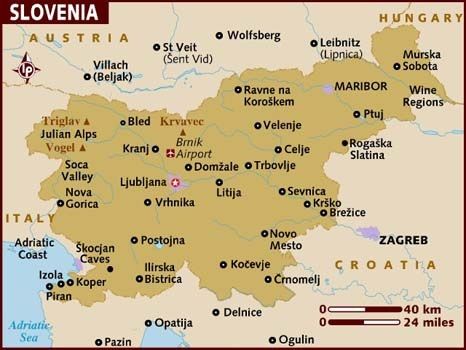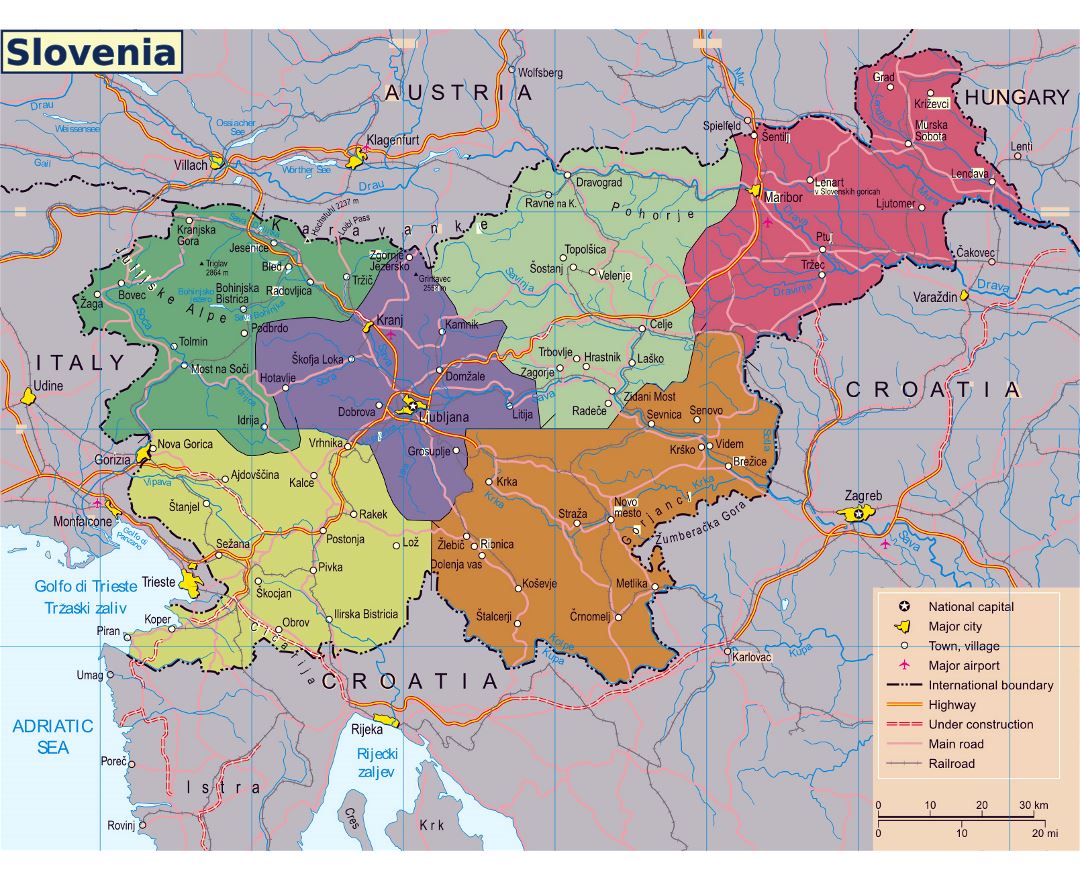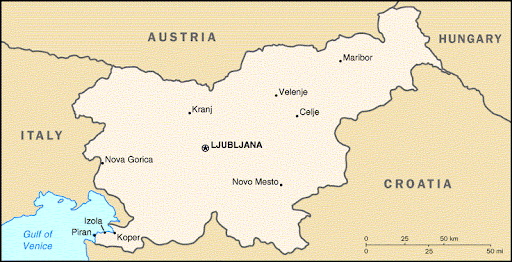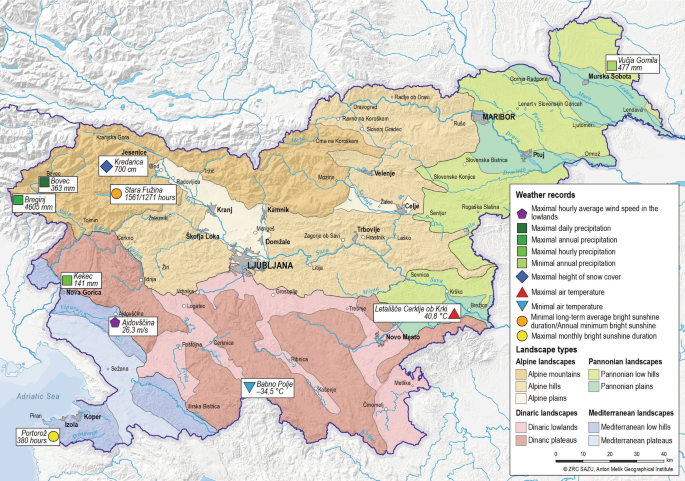Map Of Slovenia - Key Locations, Geography, People And History
Plan your adventure with our map of Slovenia, showcasing must-see locations, cultural sites, and the diverse natural beauty of this incredible country.
Author:Finn WildeReviewer:Michael RachalDec 02, 202429.2K Shares487.5K Views
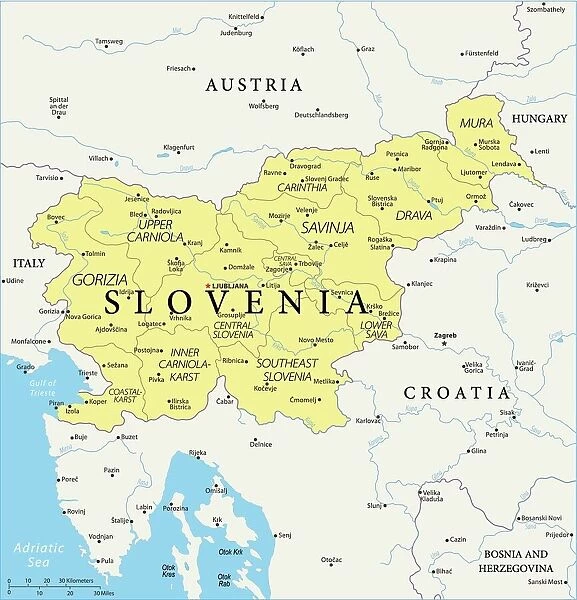
Slovenia, a picturesque country in the heart of Europe, is celebrated for its stunning landscapes and rich cultural heritage. With a history dating back to ancient times, Slovenia has been shaped by various civilizations, including the Romans and the Austro-Hungarian Empire.
After gaining independence from Yugoslavia in 1991, it emerged as a vibrant democracy and a member of the European Union. This article provides insights into Slovenia’s major cities, geographical features, and tourist attractions, helping readers appreciate the beauty and history of this enchanting destination.
Geographical Overview Of Slovenia
Slovenia is situated in the heart of Europe, bordered by Austria to the north, Italy to the west, Hungary to the northeast, and Croatia to the south and southeast. The country covers an area of approximately 20,273 square kilometers (7,827 square miles), making it one of the smaller countries in Europe. Despite its size, Slovenia boasts a diverse range of landscapes, including the Julian Alps, the Karst Plateau, lush valleys, and a charming coastline.
Similar to Scottish flags, which carry rich cultural significance, Slovenia’s diverse geography and location reflect its unique cultural identity. This geographical diversity contributes to a variety of climates and ecosystems, supporting a rich array of flora and fauna. The country's location along key trade routes has also played a significant role in shaping its history and development.
Capital Of Slovenia
The capital of Sloveniais Ljubljana, located in the central part of the country. Ljubljana is the largest city in Slovenia, with a population of over 280,000. It is the political, cultural, and economic heart of Slovenia.
Known for its beautiful old town, vibrant arts scene, and historical landmarks such as Ljubljana Castle and Prešeren Square, Ljubljana offers a perfect blend of tradition and modernity. The city is also home to many museums, galleries, and theaters, making it a hub of culture in the country.
Map Of Slovenia Cities
1. Ljubljana
Ljubljana, the capital city, is known for its charming architecture and vibrant cultural scene. Its historic center features beautiful Baroque and Art Nouveau buildings, with landmarks like Ljubljana Castle and the Triple Bridge. The city is also recognized for its green spaces, including Tivoli Park, and is a hub for festivals, art exhibitions, and lively markets.
2. Maribor
Maribor is Slovenia’s second-largest city, situated on the banks of the Drava River. It is famous for its wine culture, particularly its Old Vine, which is considered the oldest vine in the world. The city hosts numerous wine festivals and events, celebrating its rich viticultural heritage. Maribor is also known for its picturesque old town and the beautiful Maribor Castle.
3. Celje
Celje is known for its medieval history and charming old town. The Celje Castle, which dates back to the 12th century, offers stunning views of the city and is a popular tourist attraction. The city has a vibrant cultural scene, with various events and festivals throughout the year, reflecting its historical significance.
4. Kranj
Kranj, located at the confluence of the Sava and Kokra rivers, is known for its well-preserved medieval architecture and historical sites. The city is a hub for outdoor activities, with numerous trails and parks in the surrounding area. Kranj also hosts cultural events and has a lively arts scene, making it an appealing destination.
5. Nova Gorica
Nova Gorica lies on the border with Italy and is known for its vibrant nightlife and cultural events. The city features modern architecture and numerous parks. Nova Gorica is also home to the annual Wine Festival and other cultural celebrations, reflecting the region’s rich heritage.
6. Ptuj
Ptuj is one of the oldest towns in Slovenia, known for its medieval architecture and rich history. The Ptuj Castleoverlooks the town and hosts a museum with a collection of historical artifacts. Ptuj is famous for its annual carnival, which attracts visitors from all over the country, showcasing traditional masks and festivities.
7. Velenje
Velenje is known for its industrial heritage, particularly in coal mining. The city features modern architecture and offers recreational opportunities, including lakes and parks. Velenje is also home to cultural institutions, such as the Velenje Museum, which showcases the city’s history.
8. Piran
Piran is a coastal town located along the Adriatic Sea, known for its Venetian-style architecture and beautiful beaches. The town features narrow streets, charming squares, and stunning views of the sea. Piran is a popular destination for tourists, offering a mix of history, culture, and relaxation by the water.
9. Murska Sobota
Murska Sobota is located in the northeastern part of Slovenia and serves as the cultural and administrative center of the Pomurje region. The town is known for its spa resorts and thermal baths, attracting visitors seeking relaxation and wellness. Murska Sobota also hosts various cultural events, celebrating the region’s heritage.
Regions On The Map Of Slovenia
1. Alpine Region
The Alpine region is characterized by stunning mountain landscapes, including the Julian Alps and the Kamnik-Savinja Alps. This area is popular for outdoor activities such as hiking, skiing, and mountaineering. Triglav National Park, home to Slovenia's highest peak, Mount Triglav, offers breathtaking views and diverse ecosystems.
2. Pannonian Plain
The Pannonian Plain covers the northeastern part of Slovenia and is known for its flat terrain and fertile agricultural land. This region is essential for farming, producing crops such as corn, wheat, and sunflowers. The lowlands are also dotted with charming towns and villages that showcase traditional Slovenian culture.
3. Mediterranean Region
The Mediterranean region along Slovenia's coastline features a warm climate, beautiful beaches, and charming coastal towns. The city of Piran is a highlight, known for its Venetian-style architecture and lively atmosphere. This area is popular for tourism, offering opportunities for water sports, dining, and relaxation.
4. Dinaric Region
The Dinaric region is known for its karst landscapes, characterized by limestone formations, caves, and underground rivers. The Škocjan Caves and Postojna Cave are among the most famous attractions, drawing visitors from around the world. This region also hosts several national parks that protect its unique natural heritage.
Population
Slovenia has a population of approximately 2.1 million people, making it one of the least populous countries in the European Union. The population is ethnically homogeneous, with the majority being Slovenes, but it also includes minorities such as Hungarians and Italians. The capital city, Ljubljana, is the most populous, serving as the cultural and economic center of the country.
Slovenia’s population density varies significantly across regions, with urban areas experiencing higher concentrations compared to rural areas. This distribution impacts the social dynamics, economic activities, and cultural practices within the country.
Currency Of Slovenia
Slovenia uses the Euro (€) as its official currency, which it adopted in 2007. The use of the Euro facilitates easier trade and travelwithin the Eurozone, making it convenient for visitors from other European countries.
Virtual traveloptions have also increased accessibility, allowing people worldwide to explore Slovenia's beauty from afar. The currency's stability has contributed to Slovenia's relatively stable economy compared to some neighboring countries.
Dialing Code Of Slovenia
The dialing code for Slovenia is +386. This is the prefix used when dialing Slovenian phone numbers from abroad. If you are calling a Slovenian number from outside the country, you will need to include this dialing code before the local phone number. Slovenia's phone network is well-developed, and mobile phones are commonly used throughout the country.
Language Of Slovenia
The official language of Slovenia is Slovene (or Slovenian). It is a South Slavic language and is spoken by the majority of the population. Slovene has several dialects, which vary by region, but the standard Slovene used in education and media is based on the central dialect spoken around Ljubljana.
In addition to Slovene, many Slovenes also speak English, particularly in urban areas and tourist destinations. Other languages spoken in Slovenia include Italian, Hungarian, and Serbian, reflecting the country’s multicultural heritage and its proximity to other European nations.
Flag Of Slovenia
The flag of Slovenia consists of three horizontal stripes of white, blue, and red, with the national coat of arms positioned in the upper left corner. The white represents peace and honesty, the blue symbolizes the sky, the sea, and the Adriatic coast, and the red stands for courage and valor.
The coat of arms displays a Mount Triglav, Slovenia’s highest peak, surrounded by two blue wavy lines representing the country's rivers. The flag reflects Slovenia's historical connection to the South Slavic nations and its rich natural heritage.
Government Of Slovenia
Slovenia operates as a parliamentary republic, where the President serves as the head of state, while the Prime Minister holds the position of head of government. The Slovenian parliament, known as the National Assembly, is a unicameral legislative body composed of 90 members, who are elected every four years.
Slovenia is also a member of several international organizations, including the European Union, the United Nations, and NATO. The country follows a democratic and transparent governance system, with a strong focus on human rights and rule of law.
Total Area Of Slovenia
Slovenia's total area of 20,273 square kilometers makes it relatively small compared to its neighbors, but its varied landscapes offer a wealth of natural beauty. The country's compactness allows for a wide range of geographical features within a short distance, from alpine peaks to flat plains and coastal regions.
The elevation ranges from sea level along the Adriatic coast to over 2,800 meters (9,186 feet) in the Julian Alps, creating diverse climates that influence agriculture, tourism, and local lifestyles. This variation in geography not only enhances Slovenia's natural beauty but also contributes to its ecological richness.
Slovenia’s Borders And Neighboring Countries
A map of Sloveniaalso helps to understand its strategic location in Europe. Slovenia shares borders with four countries:
- Italyto the west
- Austriato the north
- Hungaryto the northeast
- Croatiato the south
These borders connect Slovenia to the rest of Europe, making it an ideal starting point for travelers looking to explore the continent. Its location also makes Slovenia an essential point of connection for trade and tourism.
National Parks And Landscapes
1. Triglav National Park
Triglav National Park is Slovenia’s only national park and is known for its stunning alpine scenery. The park offers numerous hiking trails, including those leading to the summit of Mount Triglav, the country’s highest peak. It is home to diverse flora and fauna, making it a hotspot for nature lovers.
2. Soča Valley
The Soča Valley is famous for its emerald-green river, known as the Soča River, which offers opportunities for rafting, kayaking, and fishing. The valley is surrounded by breathtaking mountains and is a popular destination for outdoor activities and scenic hikes.
3. Škocjan Caves
A UNESCO World Heritage site, the Škocjan Caves are among the largest and most important karst caves in the world. Visitors can explore stunning underground chambers and waterfalls, making it a unique natural attraction in Slovenia.
Slovenia’s Natural Wonders On The Map
The map of Slovenia reveals not only the cities and towns but also the diverse natural wonders that make the country a paradise for outdoor enthusiasts. Below are some must-visit natural landmarks:
1. Lake Bled
- Location:Northwestern Slovenia, near the town of Bled
- Key Features:One of the most iconic images of Slovenia, Lake Bled is famous for its island church and the Bled Castle perched above the lake. A stroll around the lake or a boat ride to the island is a must-do activity.
2. Triglav National Park
- Location:Northwestern Slovenia, in the Julian Alps
- Key Features:This national park is named after Mount Triglav, Slovenia’s highest peak. It is a haven for hikers, climbers, and nature lovers, with pristine lakes, waterfalls, and a variety of wildlife.
3. Postojna Cave
- Location:Southwestern Slovenia
- Key Features:One of the largest and most visited karst cave systems in the world, Postojna Cave stretches for 24 kilometers and is famous for its dramatic stalactites and stalagmites. Visitors can take a train ride through the cave system.
4. Škocjan Caves
- Location:Southwestern Slovenia, near the Italian border
- Key Features:Another UNESCO World Heritage site, the Škocjan Caves are known for their massive underground chambers, rushing rivers, and unique limestone formations.
5. The Soča River
- Location:Northwestern Slovenia, near the Italian border
- Key Features:The emerald green Soča River is one of Europe’s most beautiful rivers. It’s a popular spot for kayaking, rafting, and fishing, and it’s surrounded by stunning alpine scenery.
Major Roads And Transportation
- A1 Highway: This is Slovenia's primary north-south highway, connecting the capital, Ljubljana, to the coastal city of Koper. It serves as a crucial route for trade and travel, facilitating easy access to major urban centers and ports.
- A2 Highway: This highway runs from the border with Austria near Jesenice through Ljubljana to the southern border with Croatia. It is an essential route for both domestic and international traffic, connecting key cities and regions.
- A3 Highway: Connecting Slovenia with Croatia, the A3 highway runs through the eastern part of the country and is vital for regional commerce and tourism.
- H1 and H2 Highways: These highways provide important connections between smaller towns and the major highways, ensuring accessibility across the country.
- Road to Lake Bled: This scenic road connects the major highway network to one of Slovenia’s most famous tourist destinations, Lake Bled, enhancing accessibility for visitors.
Public Transport
Slovenia’s public transportation system includes buses and trains that connect urban and rural areas. The national railway company provides efficient services, making it easy for travelers to explore various regions of the country. Buses are also widely available, offering access to smaller towns and attractions.
Climate Map
Slovenia experiences a varied climate, characterized by a mix of oceanic and continental influences. The western part of the country, particularly along the coast, has a Mediterranean climate, while the interior regions experience a more continental climate with colder winters and warmer summers. The Alpine region has a highland climate, resulting in cooler temperatures and heavy snowfall in winter.
This diversity in climate contributes to Slovenia's rich agricultural production, with vineyards flourishing in the warmer regions and ski resorts thriving in the mountains. Understanding the climate zones is essential for appreciating the natural landscapes and activities available throughout the country.
Slovenia Economy
Slovenia's economy is diverse, relying heavily on natural resources. The country is known for its high-quality manufacturing, particularly in automotive and electronics industries. Agriculture also plays a vital role, with wine production being a significant contributor to the economy.
As with specialties like roast venison, which showcase Slovenia's culinary traditions, the country’s economic strengths are highlighted through its unique agricultural and manufacturing contributions. Tourism has become increasingly important, driven by the country’s rich biodiversity and cultural heritage. Understanding the economic landscape helps to appreciate how it is represented on the map.
How To Use A Map Of Slovenia For Travel
Using a map of Slovenia is crucial for those planning to travel or explore the country. Here are some ways a map can enhance your experience:
- Route Planning:Whether you’re traveling by car, train, or bike, a map helps you plot the most scenic routes to Slovenia’s attractions, from the coastal towns to the Alpine villages.
- City Navigation:With clear details of Slovenia’s cities and streets, a map helps you navigate urban centers like Ljubljana and Maribor without missing key sites.
- Outdoor Adventures:Slovenia is a paradise for hiking, biking, and adventure sports. A map ensures you can find the best trails and outdoor experiences in places like Triglav National Park and along the Soča River.
- Cultural Exploration:The map highlights important cultural sites, historical landmarks, and UNESCO World Heritage sites, ensuring that you don’t miss out on Slovenia’s rich history and cultural diversity.
10 Key Facts About Slovenia
- Biodiversity: Slovenia is home to diverse ecosystems, including forests, mountains, and wetlands, hosting numerous endemic species.
- Cultural Heritage: The country has a rich cultural heritage, with influences from neighboring Italy, Austria, and Hungary.
- Lake Bled: Famous for its picturesque island church and castle, Lake Bled is one of Slovenia's top tourist attractions.
- Wine Country: Slovenia is known for its quality wines, particularly from regions like Brda and the Štajerska.
- UNESCO Sites: Slovenia has several UNESCO World Heritage sites, including the Škocjan Caves and the Historic Town of Piran.
- Karst Topography: The Dinaric region is known for its karst landscapes, including unique caves and sinkholes.
- Green Capital: Ljubljana was named the European Green Capital in 2016 for its sustainability initiatives and eco-friendly practices.
- Alpine Adventure: Slovenia offers numerous opportunities for outdoor activities, including hiking, skiing, and paragliding.
- Cultural Festivals: The country hosts various cultural festivals throughout the year, celebrating music, film, and traditional crafts.
- Lively Culinary Scene: Slovenian cuisine is diverse and influenced by neighboring countries, featuring local ingredients and traditional dishes.
FAQs
What Are The Major Geographical Features Of Slovenia?
Slovenia features diverse landscapes, including the Julian Alps, the Karst Plateau, and the Adriatic coast.
How Is Slovenia Divided Politically?
Slovenia is divided into 12 statistical regions, each with its own administrative center.
What Are The Most Visited Cities In Slovenia?
The most visited cities include Ljubljana, Maribor, and Bled, each offering unique cultural and historical attractions.
How Does Slovenia’s Geography Influence Its Culture?
Slovenia’s varied geography contributes to its cultural diversity, with different regions hosting distinct traditions and lifestyles.
What Natural Wonders Can Be Found In Slovenia?
Slovenia is home to many natural wonders, including Lake Bled, Postojna Cave, and Triglav National Park.
Conclusion
The map of Slovenia showcases a nation rich in diversity and cultural heritage, featuring captivating cities and breathtaking landscapes. From the enchanting capital of Ljubljana to the coastal charm of Piran, each area offers its own unique allure. Understanding these elements enhances appreciation for Slovenia as a travel destination.
As the country continues to evolve, preserving its natural and cultural treasures is essential. By examining Slovenia's map, one gains valuable insights into a country that beautifully balances its historical roots with modern aspirations, inviting all to experience its blend of nature, history, and hospitality.
Jump to
Geographical Overview Of Slovenia
Capital Of Slovenia
Map Of Slovenia Cities
Regions On The Map Of Slovenia
Population
Currency Of Slovenia
Dialing Code Of Slovenia
Language Of Slovenia
Flag Of Slovenia
Government Of Slovenia
Total Area Of Slovenia
Slovenia’s Borders And Neighboring Countries
National Parks And Landscapes
Slovenia’s Natural Wonders On The Map
Major Roads And Transportation
Climate Map
Slovenia Economy
How To Use A Map Of Slovenia For Travel
10 Key Facts About Slovenia
FAQs
Conclusion
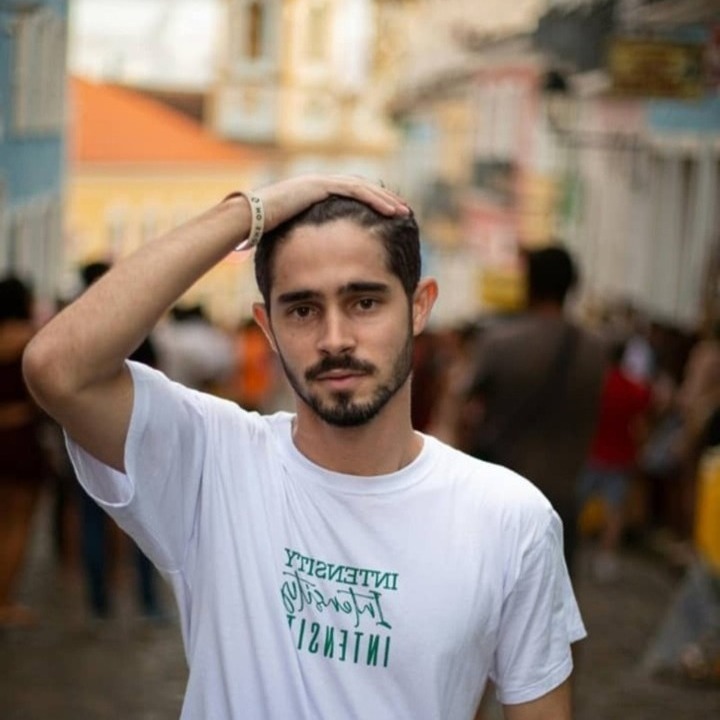
Finn Wilde
Author
For Finn Wilde, the wilderness is more than just a destination - it’s a way of life. Over the past decade, he has led multiple expeditions in some of the world’s most remote regions, from the icy fjords of Greenland to the rugged trails of Patagonia.
Finn emphasizes sustainability in all of his adventures, helping participants connect with nature while promoting responsible exploration. His expeditions inspire individuals to explore the great outdoors while fostering a deep respect for the environment.

Michael Rachal
Reviewer
Michael Rachal believes that luxury lies in the details. With over 20 years of experience in the luxury travel industry, he has crafted hundreds of bespoke itineraries for clients seeking personalized, unforgettable experiences.
Whether guiding clients through private cultural tours or curating culinary journeys with world-renowned chefs, Michael ensures that each trip is tailored to perfection.
His ability to anticipate needs and exceed expectations has earned him a reputation as a leading expert in luxury travel.
Latest Articles
Popular Articles
